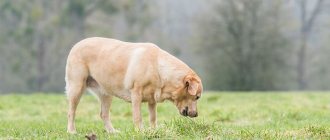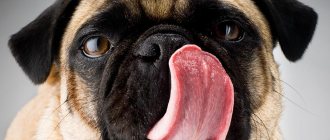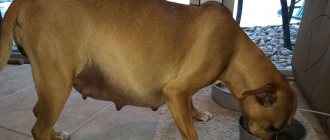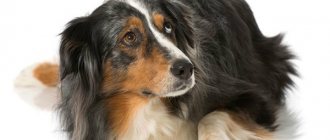Do you know how long dogs sleep? We all know that the average time for healthy sleep for a person is 8 hours. Is there such an indicator of sleep duration for animals? Let's figure this out.
The amount of time a pet spends in the power of Morpheus depends on many factors. A dog is a social animal. It completely adapts to the daily routine of its owner. As a rule, an adult animal will sleep as long as its owner sleeps. Although some little tails (for example, like our “shin-bottomed” Dzhekushka) do everything in order to wake up everyone in the household in the morning. You can read how he does this in the article:.
Even very little time is devoted to bowel movements as the dam stimulates the newborn puppy to eliminate. A newborn Chihuahua will sleep anywhere from 20 to 23 hours a day. They usually just wake up to see the nurse and this happens about every 2 hours.
A Chihuahua puppy's long-term sleeping habits will begin to change noticeably around the 3-week mark. At this time, the puppy learns to walk, the eyes are fully open, and the ability to hear is functional. This is a time of great curiosity and exploration as the puppy may be traveling from the dam.
On average, an adult animal sleeps about 12-15 hours a day. But this indicator is individual for animals and depends on many factors.
Factors influencing the sleep duration of a four-legged animal
Age
Puppies and older dogs spend much more time sleeping than healthy and young dogs. Puppies need more time to sleep because they grow while they sleep. For example, three-month-old babies can sleep up to 20 hours a day. Older dogs need more time to recuperate.
Puppies - Chihuahua puppies sleep a lot, and when they are awake they are often very active and even hyper. It's like two sides of a coin: the puppy will push away so much that owners wonder if Chi sleeps too much, but then when he wakes up he has a huge amount of energy.
From 2 to 6 months, a Chihuahua puppy can sleep up to 18 hours. From 6 months to the 1 year mark, an hour or two may be deducted from this. Your Chihuahua puppy's sleeping habits will be scattered. He may nod mid-game as he pushes himself to stay awake and enjoy what he's doing until his body just gives up and he walks away.
Breed
Representatives of large breeds also require more time to recuperate.
Weather
Just like people, weather conditions also affect our dogs. Probably every owner of a four-legged dog has noticed that on a cloudy and rainy day his pet becomes lethargic, sleepy and prefers to curl up, lie in a soft bed and snore quietly and peacefully in two holes.
Of course, the goal is for owners to try to make the most of this sleep at night, when owners want to be undisturbed in bed, and we'll go ahead. Adults - Canine breeds such as Chihuahuas that are adults at 1 year of age will sleep approximately 12 to 15 hours. This includes both at night and during sleep. Each dog will vary in how much wood he takes and for how long.
By the 1-year mark, most have learned to snooze all night and have more control over when they take naps. The young adult Chi is accustomed to his schedule now and knows when to expect walks, feeding, playtime and grooming. He can sleep between these events and usually settles down at night without much prompting.
Stress
Stress often has a big impact on how much dogs sleep. After the experience, the dog can sleep for a whole day. For example, our Jack, after exciting trips to the veterinary clinic, even for the usual annual vaccination, sleeps for half a day and comes to his senses.
Disease
Very often, when a dog is unwell, he may sleep longer than usual. Watch your pet. If, in addition to lethargy and weakness, other symptoms are observed (such as diarrhea, vomiting, lack of appetite, and so on), then in this case you need to seek help from a veterinarian.
Dogs left alone for most of the day may nap out of sheer boredom, while those who engage in interaction and activity may remain alert for much longer periods of time. Seniors - like the era of Chi, there is a gradual slowing down of the body. It will tire more easily and tend to be more frequent and lasting longer. Those who suffer from arthritis and other age-related problems may struggle to find comfort that allows them to completely relax.
You may not notice much of a difference with a 9 or 10 year old Chi, however, when the dog enters adolescence, he will sleep much more than his younger counterpart. An older Chihuahua will sleep for about 16-17 hours unless medical problems or discomfort prevent him from doing so.
Boredom
If household members are at work all day, and the four-legged one is left at home alone, then he simply has nothing left to do but sleep.
It’s another matter if the dog lives in the yard or when the family is full of children, a cat and other animals. There's no time for sleep here anymore. There's a whole bunch of things to do. Chase a cat, run after a ball with children, bark at neighbors or other people's dogs passing by. What fun! How boring it is!
Helping a Chihuahua puppy at night
Besides raising a puppy at home, training your puppy to sleep at night is the biggest challenge most owners face.
Owners wonder if the puppy was waiting for a nap because he needed a bath or simply because he wanted attention. Since you don't want to ignore the cue to go potty, how can you avoid running over to him every time he wakes up? This can actually cause sleep deprivation for many new owners, and it can be quite a drag. It can cause fatigue, affect cognitive functioning and cause headaches. It can also cause irritability and decreased stress tolerance, which can make caring for your puppy more difficult.
Estrus
During estrus, the duration of sleep for young ladies increases. They become calm and even a little sad.
When should you contact a veterinarian?
Dr. Potoski says, “I would recommend taking your dog to the vet if he becomes extremely lethargic. Anything that goes beyond her usual behavior should alert you and be a reason to visit a specialist.” As a dog owner, you are the best person to tell what dog behavior is normal and what worries you. When you see changes that are concerning, consult your doctor!
No wonder they say that a dog is man's best friend. Many of us love them as much as we love family members, and taking care of their health is just as important. This is another reason to find out how long dogs should sleep.
Most people want to sleep all day. However, this is rarely possible for anyone, and it becomes more difficult to maintain a healthy lifestyle, but, nevertheless, this is normal for dogs. On average, adult dogs sleep between 14 and 16 hours a day. The length of sleep in dogs varies greatly depending on several factors.
Sleep phases
There are two phases of dog sleep: REM and NREM.
REM sleep
REM sleep is deep sleep. It is in this phase that the activity of the cardiovascular and respiratory systems becomes more active. During sleep, the dog's whiskers begin to twitch, his lips begin to twitch, and his eyes move intensely under closed eyelids. The tail begins to whine in its sleep, twitch its paws and smack its lips. It is believed that it is during this phase that the animal dreams (chases a cat, runs after a ball, or eats something tasty).
While you may be able to imagine your dog snuggling up to you in bed, this can happen later after he is fully house trained. It is important to keep your puppy indoors, but not isolated or feel too confined. Never use a small box; this can make the puppy very stressed and often leads to more nighttime barking and other problems.
A small enclosed area that includes a comfortable dog bed works best. It should be located in a quiet area of the house. It is recommended not to have it in your own bedroom; if your puppy can't sleep simply because he feels you are so close and to him, you should interact and play no matter what time it happens.
A dog's dreams, just like a person's dreams, directly depend on his lifestyle. If the dog is a hunting dog, then in a dream he will constantly run and catch prey. But if the dog is a guard dog, then in a dream it will grumble, growl and protect the house from an invisible enemy.
Despite the fact that during the rapid phase of sleep the four-legged dog behaves so restlessly, and this phase is very short and makes up only 25% of the total amount of sleep time, it is still deep sleep and the nervous system also rests.
Lower the lights and lower the volume on the TV. While you don't need to resort to whispering, a calm and quiet voice can help give the general idea of a calm and calm environment. If there is any belief that your Chihuahua puppy is not sleeping because he needs to go to the bathroom, you should listen to it.
You want the lamps to be very low and keep talking to a minimum. Once the deed is done, put him back on the bed, give him a quick pat and walk away. It's hard to do, but you will be helping him in the long run.
slow sleep
Slow or light sleep is characterized by decreased muscle tone. The dog's breathing normalizes and calms down, and the heart rate slows down. NREM sleep is characterized by the absence of dreams and serves to restore the dog's physical strength.
Continuing our research on how long dogs sleep, let's talk about why, when going to bed, the dog begins to spin like a top.
One of the best ways to train your Chihuahua puppy to sleep at night is to show him that absolutely nothing interesting, or anything at all, happens at night. There is no play, there is no pleasure, and no one talks. He will not calm down, and he will not sing a lullaby. In fact, life is so boring when it's dark, lies retreat and put off until the morning, when there is interaction, fun, pleasure and attention.
If the puppy simply urinated and eliminated, and he stayed only to get attention, he should be allowed to sleep on his own. Owners who rush every time there is a yelp or whine will actually train the puppy to call all night long. This can create a foundation of terrible habits that are not easy to change.
Why, when going to bed, does the dog begin to spin around and “dig” its sleeping place?
This behavior of the four-legged animal is caused by the genetic memory of its ancestors - wolves. When going to bed, the wolves would tear up leaves or snow to make something like a nest, and then spin around in place, crushing the grass underneath them and preparing a rookery.
Review is a condition in which breathing patterns disrupt sleep. This is typical for both people and their pets. It most often affects brachycephalic breeds such as the pug, where the air passages become swollen and narrow. However, Chihuahuas may have stenotic nostrils or an elongated palate, which causes breathing problems, especially when the dog is lying down.
It's common for first-time dog owners to be surprised by how much time their new dog kisser spends sleeping. It's like they sleep all day, every day, and do some more! Of course this is not true, but how many dogs slept? And why did the dogs sleep so much?
The fact is that the safest and most functional sleeping position for a wolf was the “ring” or “curl”. In this position, the animal loses less heat, instinctively protects all vital organs, and the walls of the constructed “nest” also protect it from the outside. That’s why, obeying the call of our ancestors, our fluffy (and not so fluffy) little tails love to “dig” their bed before going to bed.
While the exact amount of sleep your dog will enjoy over a 24-hour period varies, the average is usually between 12 and 14 hours per day. Additionally, while we humans sleep in one long block of 7 to 9 hours every night, your dog's sleep patterns are much more disrupted. Consequently, they need much more sleep to be as rested as we humans are.
When there is nothing to do, dogs will sleep
Another reason you may find your dog sleeping a lot is because there isn't much to do for them. This is why you will typically find that working dogs sleep less than their domestic counterparts because they are stimulated for more time during the day.
Congenital pathology
Congenital diseases of the heart and blood vessels, nervous system, and endocrine glands often lead to a decrease in body temperature - hypothermia. Normally, a pet's temperature should exceed 37 degrees. At low temperatures, metabolic processes in the dog’s body slow down and it becomes lethargic. Severe trauma during childbirth can cause serious damage to the nervous system, causing a decrease in the animal's activity. Such a diagnosis cannot be established independently. This is done by a veterinarian after a thorough examination.
Weakness and intoxication may be associated with skin diseases. The animal itches all the time, hair is constantly coming out. Red spots of inflammation are visible on the skin.
Tumors of various locations may also present with drowsiness. A complete cure is possible for the disease at an early stage. After identifying the location of the tumor, surgery is performed to remove it. X-rays and ultrasound will help in diagnosis.
Chronic illnesses can lead to decreased activity. If you suspect them, visit the veterinarian for a routine examination, possibly take tests (blood and urine) and conduct a more in-depth examination of the dog. Any pathology detected at an early stage can be completely cured.
Drowsiness is not a disease, but a symptom. Treating it at home is pointless and useless. Perhaps the puppy is simply too small for active play and wants to sleep. But if the animal refuses to eat and does not want to go for a walk, immediately contact a veterinarian. In any case, it won’t hurt to undergo a preventive examination.
Your alarm clock starts ringing seconds after the dog's cold, wet nose presses against your cheek and its eager tongue licks your face. It's time to get up!
You force yourself to get out of bed to walk the dog and take a shower. An hour later, when you've both had breakfast, you have to go to work, while your furry friend goes to his bed, gets comfortable and begins to snore quietly. You sigh longingly and walk out the door.
Why do dogs sleep so much? Humans need six to eight hours of sleep per night, but how much should dogs sleep? It seems as if they sleep all the time, but is there a limit?
In fact, these questions can be answered. Unless your dog has suddenly changed his sleeping habits, there is probably no cause for concern.
Positions that dogs like to sleep in
So, we already know how much dogs sleep, and now let’s look at what positions our beloved little tails like to sleep in.
As I wrote before, the most common sleeping position is “Kalachik”. This is the safest position for the animal, in which it feels most protected.
If you think your dog might be bored, walking, playing games like fetch and simply interacting with them will keep their minds and bodies active when they would otherwise be dozing off. This video is full of ideas on the best ways to relieve your dog's boredom and keep them active.
The connection between diet and sleep
Diet can also play a significant role in your dog's sleep habits, as dogs get their energy from what they eat. If you feed them a low quality diet full of cheap litter, they won't get the nutrition they need to be active, so they'll likely sleep more.
On the side
Very often dogs like to sleep on their sides with their paws extended forward. In this position, the dog feels a sense of comfort and security.
On the back
If your pet loves to sleep on its back, then you have absolutely nothing to worry about. He feels completely relaxed and happy. A dog's stomach is one of the most vulnerable places. By opening his tummy, your pet shows that nothing is bothering him and he trusts you completely.
Making small adjustments to your dog's diet to allow them to eat should mean they have more energy to engage in play and exercise. Lower nutrient foods take more time and energy to digest so can really slow your dog down.
Could excess sleep signal be a problem?
While sleeping a lot is normal for most dogs, a sudden change in sleep patterns—such as sleeping a lot more or showing signs of lethargy—is not. This may indicate a health problem. Blood depression, diabetes and hyperthyroidism can cause your dog to become lethargic and sleep much more than usual. Infectious diseases such as havoc, parvovirus, rabies and Lyme disease will also have similar effects.
Small puppies like to sleep in this position; nothing bothers them, and there are no reasons for worry yet. Or dogs that have used up a lot of energy during the day. In the wild, you will never see wolves sleeping in this position, as it indicates their vulnerability and subordination.
What should I do if my dog doesn't sleep anymore?
Check to see if you notice any sudden changes in your dog's sleeping pattern, or if you are concerned they are sleeping excessively, to rule out any underlying health conditions.
On the other hand, if you are worried that your dog is not getting enough sleep. Some factors that can cause anxiety in dogs include metabolic conditions such as hyperthyroidism, medication side effects, anxiety, chaotic households, or even allergies. There are many on the market that will provide your dog with a restful and supported night's sleep, which is especially important for older dogs or those suffering from physical discomfort. If you live in a particularly hot or cold climate that you think may affect your dog's ability to sleep, take a look at related accessories on the market.
On the stomach
Many dogs sleep on their stomachs. But, despite the fact that the stomach seems to be protected, in this position the dog does not feel completely relaxed. She is ready to jump up and run at any moment.
Leaning back against a person
Earlier, in the article: I already wrote that if your pet sleeps with its back pressed against you, this means that it trusts you 100%. After all, by leaning his back against you, he can control what is happening around him. And your back is reliably protected.
Cooling pads and air conditioners may be necessary, for example, if you live in an unusually hot climate, while blankets and special dog sweaters may be in order in colder places. Most dogs don't drink, so they never have a good excuse to lose their balance, especially since they have four, not two, legs to stand on. If your dog's balance seems off, it's always worth taking a look. Possible causes to look for to explain inconsistency or ataxia include infection, systemic disease, toxin ingestion, dehydration, electrolyte imbalance, and head injury or other intracranial problems such as hemorrhage, stroke, aneurysm, or tumors.
Today we talked about how much dogs sleep, what affects the duration of their sleep, and what positions four-legged dogs like to sleep in.
What position does your pet like to sleep in? Share with us in the comments, because it’s very interesting!
Good luck and take care of your pets!
Like all carnivores, a dog needs to sleep quite a lot. The average sleep rate for these animals is 12-16 hours a day. However, many different factors can influence how much sleep a given dog gets in any given period.
Take your dog to the vet if you notice these 12 symptoms
A responsible owner does not forget to care for his dog, gives vaccinations, carries out hygiene procedures and monitors the regime.
But how can you notice in time that something is wrong with your pet and not miss the onset of a serious illness? Veterinarians say that not only dangerous syndromes, such as vomiting, bleeding or lameness, should alert the owner, but also changes in the dog’s behavior and reactions, and its character.
We at Bright Side drew attention to non-obvious signs that require taking your dog to a specialist.
Some diseases in dogs, especially purebred ones, develop rapidly, and it is better to make a mistake in suspicion than to lose sight of something important.
Particular vigilance must be exercised when the animal’s immunity may be weakened: during teeth changes, during periods of cold, extreme heat, and tick activity.
If you notice that the dog has stopped moving its tail and it remains motionless in any condition, then most likely it may be “cold tail syndrome”. The causes of this condition are minor injuries and hypothermia of the dog, especially if the tail gets wet.
Acute inflammatory disease of the tail muscles affects mostly young large dogs, whose tail hangs like a whip either immediately from the root, or “breaks” at a distance of about 10 cm from the root. The most painful muscles may be closest to the caudal vertebrae.
Dogs react poorly to the feeling of the tail, and their general health may also deteriorate, especially in the initial stage of the disease. Treatment is rest and procedures prescribed by the veterinarian.
Prevention of the syndrome in winter is active walks and thorough drying of the tail after getting wet.
If the dog is cheerful and playful, but too often does not fit into turns or walks unevenly, this is a reason to suspect ataxia, that is, a coordination disorder. This condition can be caused by head injuries, otitis media, infection, or neurological problems. If “awkward” behavior lasts several days, this is a reason to examine the dog.
In some breeds, especially fluffy ones - for example, collies, huskies, Spitz - an increase in the abdomen may not be immediately noticeable. But in lean Dobermans or Boxers, imbalances are visible almost immediately.
If you pay attention to this, but the dog’s diet has not changed, then problems with the digestive system are possible. Ascites (dropsy), caused by liver disease or neoplasms, may be indicated by an enlarged abdomen and symptoms such as loss of strength, rapid heartbeat, vomiting, and also the fact that the dog has stopped asking to go for a walk (that is, rare urination).
Increased drowsiness in an animal can most often be observed in the summer, with heat or sunstroke. This condition begins precisely with apathy, and at first the owner may not notice anything. Later, weakness and shortness of breath, fever and redness of the mucous membranes may occur.
Overweight dogs and breeds such as pugs, boxers, sharpeis, huskies and malamutes are especially susceptible to heatstroke. Please note that heatstroke can occur not only outdoors; it most often occurs in dogs in hot rooms, such as in a car.
You should definitely pay attention to these manifestations, as veterinarians warn: this could be the start of a common cold, or maybe canine distemper.
Distemper is the most dangerous disease of dogs, but many animals recover quite successfully if treatment is started on time. It is time that is most important here. Almost any unvaccinated animal has a risk of getting sick: the virus is very easily transmitted.
Prevention - maintaining a healthy dog’s immunity (walks, vaccinations, anti-parasitic procedures).
If the virus reaches an animal through airborne droplets, the first symptom is watery eyes and sneezing. If through the stomach, then the dog refuses to eat, and there may be stool upset.
A dog's reluctance to run can be attributed to age or heat, but it can also be the first symptom of heart disease. Observe the animal for several weeks to make sure this is not an isolated incident of this behavior.
Low temperature is a much more dangerous condition in dogs than high temperature. Because it is difficult to normalize it at home, it can continue to fall and provoke arrhythmia and subsequent cardiac arrest.
Normal values are considered to be 37.5–39 degrees, while values below 35 degrees are considered dangerous.
When a dog's temperature drops, this is noticeable in its behavior: the animal curls up into a ball, trying to warm up, trembles, and its fur fluffs up to increase the air gap between the skin and the external environment.
You can help your dog at home only if you are absolutely sure that the dog has become hypothermic outside. You need to wrap the animal, give it warm water and cover it with bottles of hot water. If the temperature continues to drop, you need to urgently go to the veterinarian.
The dog drinks much more than before, the volume of urine has increased - if this condition does not go away for several weeks and is not associated with food, then it may indicate the development of diabetes. The same symptoms are caused by kidney failure or problems of the genital organs. In this case, the symptom is the same, but the mechanisms of occurrence of this phenomenon are completely different.
© Depositphotos, © Depositphotos
Lameness in a dog may not be pronounced and develop gradually, which is typical for arthritis, dislocations and sprains. Large breeds, such as Malamutes, Great Danes, Mastiffs, Newfoundlands, due to the high load on their joints, can be injured even if they stumble on the stairs.
Therefore, it is necessary to control their weight and engage them in physical activity to strengthen their joints. The danger for medium breeds is fights with other animals. But small breeds are more often injured by their owners: they are caused by an unsuccessful hand jump or careless handling of the dog.
If you notice that your dog is moving slightly differently than before, you can do a lameness test to evaluate your dog and begin treatment.
To do this, you will need to walk with the animal on wet sand or wet soil so that the pet's paw prints are imprinted on the surface. Now you need to measure the length of the dog's stride and compare them.
The step of a limb that is limping may be shortened; the paw may be carried outward or, conversely, turned inward.
Veterinarians advise regularly examining the dog's mouth, then gum inflammation or tartar can be noticed at an early stage. An unpleasant odor may appear due to these problems, but if everything is in order with the oral cavity, then it may indicate problems with the stomach.
If a pungent odor emanates from the dog’s skin or fur even a short time after bathing, then it is worth checking it for parasite infection and diabetes.
Food allergies aren't just limited to humans—dogs are susceptible to them too. The most common symptoms are skin irritation and itching. If your dog begins to itch frequently, check the skin under the fur to see if ulcers or hives have appeared there.
Often, due to allergies, the ears become inflamed and small discharges appear in them, which are difficult to notice until the dog begins to scratch his ears.
If a puppy or young dog does this, it can be attributed to shortcomings in upbringing. But, if an adult dog begins to show a sharp interest in candy wrappers, paper, various garbage, socks, and the like, this may be a symptom of a diet disorder, infectious diseases (including rabies), helminth infection, or intestinal problems.
Anxiety for the health of your pet is comparable to anxiety for a child, because this is a real member of the family. There is no need to panic, but you should pay attention to behavioral patterns so that your dog is always cheerful and cheerful. Tell us about your pets! Or maybe you have stories of how your powers of observation saved the life of an animal?
Preview photo Depositphotos
Source: https://www.adme.ru/zhizn-zhivotnye/pokazhite-sobaku-veterinaru-esli-zametite-eti-12-simptomov-2228665/
When do dogs sleep more?
The fewer problems a dog has and the more monotonous its existence, the more time it will spend sleeping. So, domestic dogs always sleep much more than street dogs. After all, they do not need to look for a warm corner and food, or to defend the territory. And there is much less entertainment within four walls than on the street. That's why apartment dogs sleep more out of boredom.
The length of sleep is affected by the size of the dog, and even the breed. So, the larger the dog, the more time it needs to sleep. They especially like to sleep:
Much depends on age. Puppies, like children, need a lot of sleep. As they age, they sleep less and less. But as the dog ages, he begins to sleep more again. Health conditions can also make your dog sleep more. Many diseases lead to drowsiness due to weakness.
When do dogs sleep less?
During the active periods of its life, the dog clearly has no time for sleep. At work, on a hike, or while hunting, she can remain cheerful for many hours. True, then, when everything is over, she will fall asleep for a long time, restoring her strength. Some diseases also cause overstimulation, which prevents the dog from sleeping peacefully.
How does a dog sleep?
In fact, not all the time when a dog lies with his eyes closed - he sleeps. Most of the time she just dozes, completely controlling her environment, listening to all sounds. Dogs wake up very often.
The dog also has a sensitive sleep phase, when it is also able to control everything around it. And occasionally the animal falls into a deep or, as it is also called, restless sleep. It lasts for several minutes and at this moment the dog can yelp, squeal, move its paws as if running, growl, roll its eyes under closed eyelids and even jump up.
This dream is also called paradoxical. Typically there are one to three periods of such sleep, with short periods of restful sleep in between. The dog lies in a variety of positions: on its stomach, on its side, curled up, on its back. The supine position is most often preferred by puppies and very young dogs. The deep sleep stage most often occurs when the animal lies on its side with its legs extended.











